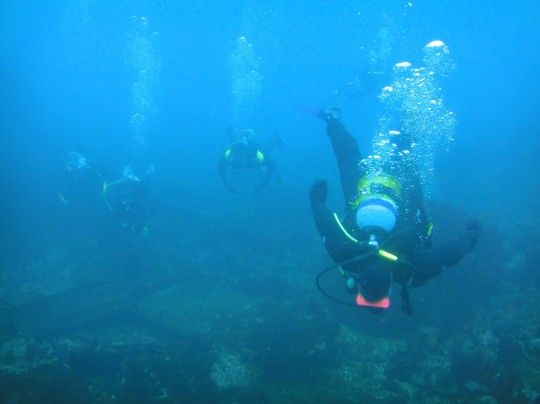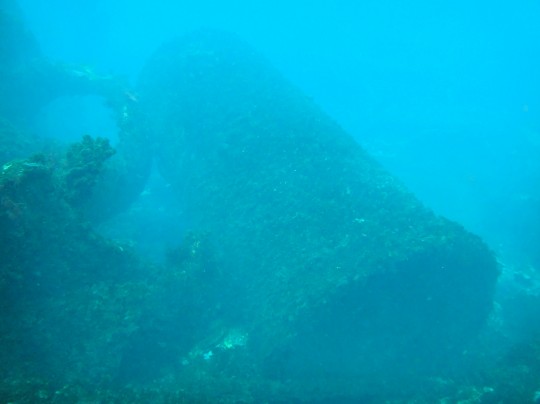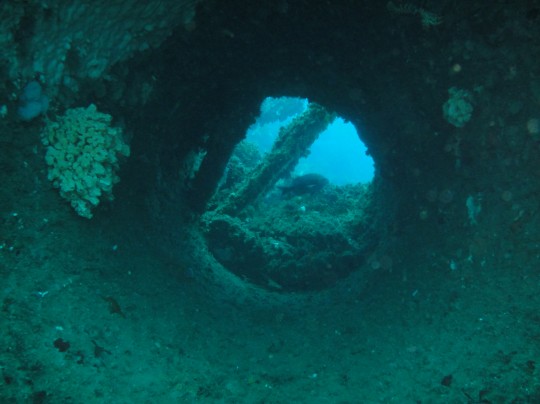I have done one prior dive on the SS Maori, about a year ago. It was one of the most unpleasant experiences of my life, one I am not keen to repeat. The boat ride was harrowing – we took the narrow channel between Duiker Island and the mainland, and I had my eyes closed for most of it. I am not a good sailor, but Tony is, and even he was seeing his life flash before his eyes. Huge waves were coming from all directions and we later learned that the skipper had been so terrified negotiating the channel that he’d called the owner of the dive shop as soon as he’d dropped the divers into the water, and practically sobbed.

We were actually intending to visit the BOS 400, but when we got there the surge through the wreck was incredibly strong and the entire superstructure was creaking ominously. A call was made to go to the SS Maori instead – it’s a couple of hundred metres from the crane and the wreck is scattered on the seabed rather than being still mostly intact. The dive itself was extremely stressful – maybe 3 metres visibility, temperatures so cold that I sucked my tank dry in about 20 minutes (ended up on Tony’s octo), strong surge on the bottom that made it impossible to control where one was going, and I honestly didn’t see anything that I could describe as a wreck.

The experience we had diving the Maori on Reconcilation Day could not have been more different. Tami and I were finishing our Wreck Specialty course, Cecil was finishing his Open Water course, and Tony had a group of casual divers with him. The boat ride was a pleasure, apart from the smell (or rather, taste!) of the seals on Duiker Island as we sped past. The water was so blue that Grant could see the wreck below us while he dropped the shot line.

The SS Maori ran aground in Maori Bay (named after it) in 1909 in thick fog. The ship lies perpendicular to the mainland, depth ranging from about 6 metres down to about 22 metres towards the centre of the bay. The ship was carrying a cargo of railway lines, cast iron pipes (visible in great stacks that are very tempting to try and swim through – common sense won out), explosives, and crockery. A fair amount of beautiful porcelain is still visible on the site, but apparently it’s been well worked and looted over the years.

The visiblity on this dive was sufficient (20 metres or so) for us to be able to see far down the ship as we explored. Parts of the wreckage are very broken up, but there are large parts of the wreck that are relatively intact. We descended on the engine block, at the shallow end of the wreck, and into beautiful kelp forests that glistened green in the clear water. It was cold, very cold, but having something amazing to look at tends to distract one from the inconvenience of chilly fingers.

As far as sea life goes, there’s a fair amount of kelp and other sea plants. Oscar found me a huge cuttlefish to photograph, just posing nicely on a rock, and there were some molluscs, the odd nudibranch, lots and lots of rock lobsters and crabs. We also saw a nice school of hottentot. Like the BOS 400, though, you visit this site first to look at the wreckage. Anything else you see is a bonus.

I can see why the Maori is such a popular dive site – we thoroughly enjoyed ourselves and Tami and I were heartbroken when we had to ascend, as our air reached 70 bar. It’s a very large site and several dives are required to appreciate its full scope. I plan to do those several dives, and then some!

Dive date: 16 December 2010
Air temperature: 23 degrees
Water temperature: 4 degrees (that’s what my computer said!)
Maximum depth: 19.9 metres
Visibility: 20 metres
Dive duration: 32 minutes







